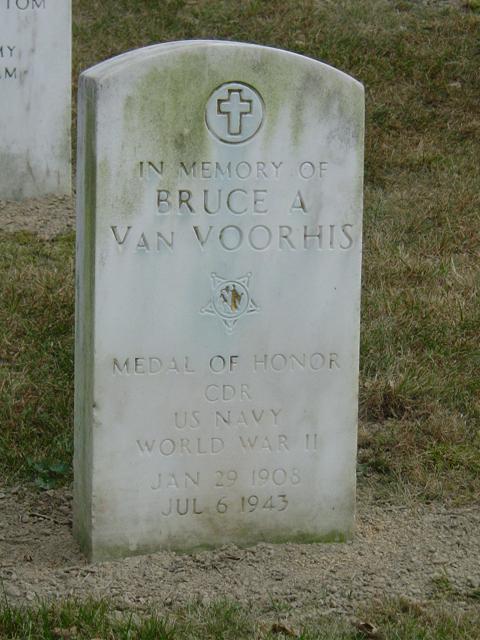Bruce Avery Van Voorhis (29 January 1908 – 6 July 1943) was a United States Navy aviator who was shot down in the Pacific theater during World War II. For his heroic action on July 6, 1943, he was posthumously awarded the Medal of Honor.
Van Voorhis was born on 29 January 1908 in Aberdeen, Washington, and grew up in Nevada, He was appointed to the Naval Academy in June 1925.
Following graduation from the Academy on 6 June 1929, Ensign Van Voorhis reported for duty in the battleship Mississippi (BB-41). That assignment lasted until November 1930 when he transferred to the Naval Air Station at Pensacola, Florida, for aviation training.
He received his wings on 3 September 1931, and was assigned to the Maryland (BB-46) as a member of Observation Squadron 4B (VO-4B). In June 1934, he transferred to Bombing Squadron 5B on board the aircraft carrier Ranger (CV-4), and soon thereafter, to VB-2B attached to Saratoga (CV-3). From July 1935 until May 1937, he served in the Panama Canal Zone and flew patrols from Coco Solo with Patrol Squadron 2F (VP-2F). The following June, 1938, Van Voorhis returned to carried-based aviation and served first in Enterprise (CV-6), then in Yorktown (CV-5), and finally back to Enterprise. In June 1940, Van Voorhis joined the aviation unit assigned to the light cruiser Honolulu (CL-48) where he served for a year. In July 1941, he reported for duty at the Naval Air Station, Anacostia, where he served until November 1942.
In December 1942, Van Voorhis, a Lieutenant Commander since July, assumed command of VP-14, but soon thereafter took command of VB-102. While serving in that capacity, LCDR Van Voorhis gave his life for his country near Hare Island of Kapingamarangi Atoll, the southernmost of the Eastern Caroline Islands. After a 700-mile flight alone, LCDR Van Voorhis launched successive bombing and strafing attacks on the enemy ground installations. During his onslaught, he succeeded in destroying a radio station, anti-aircraft emplacements, and at least one airborne fighter as well as three others on the water. However, the strength of Japanese aerial opposition eventually forced Van Voorhis lower and lower until either the intense anti-aircraft barrage, the fighters, or-perhaps-his own bomb blasts knocked him out of the sky near the island. For the “. . . conspicuous gallantry and intrepidity . . .” he displayed in his “. . . lone but relentless battle against overwhelming opposition . . .” He died on July 6, 1943 and was awarded the Medal of Honor, posthumously.
Medal of Honor citation:
For conspicuous gallantry and intrepidity at the risk of his life above and beyond the call of duty as Squadron Commander of Bombing Squadron 102 and as Plane Commander of a PB4Y-I Patrol Bomber operating against the enemy on Japanese-held Greenwich Island during the battle of the Solomon Islands, 6 July 1943.
Fully aware of the limited chance of surviving an urgent mission, voluntarily undertaken to prevent a surprise Japanese attack against our forces, Lieutenant Commander Van Voorhis took off in total darkness on a perilous 700-mile flight without escort or support. Successful in reaching his objective despite treacherous and varying winds, low visibility and difficult terrain, he fought a lone but relentless battle under fierce antiaircraft fire and overwhelming aerial opposition.
Forced lower and lower by pursuing planes, he coolly persisted in his mission of destruction. Abandoning all chance of a safe return he executed 6 bold ground-level attacks to demolish the enemy’s vital radio station, installations, antiaircraft guns and crews with bombs and machine gun fire, and to destroy 1 fighter plane in the air and 3 on the water. Caught in his own bomb blast, Commander Van Voorhis crashed into the lagoon off the beach, sacrificing himself in a single-handed fight against almost insuperable odds, to make a distinctive contribution to our continued offensive in driving the Japanese from the Solomons and, by his superb daring, courage and resoluteness of purpose, enhanced the finest traditions of the U.S. Naval Service. He gallantly gave his life for his country.
Namesakes:
The U.S. Navy Dealey-class destroyer escort USS Van Voorhis (DE-1028) was named in honor of LCDR Van Voorhis. The Van Voorhis was commissioned on on 22 April 1957; she was decommissioned on 1 July 1972.
The airfield at Naval Airstation Fallon is named in honor of LCDR Bruce Van Voorhis.
NOTE: While Commander Van Voorhis is actually buried at the Jefferson Barracks National Cemetery in Missouri (see below), there is an “In Memory Of” stone in his name at Arlington National Cemetery.
VAN VOORHIS, BRUCE A
CDR US NAVY
WORLD WAR II
DATE OF BIRTH: 01/29/1908
DATE OF DEATH: 07/06/1943
BURIED AT: SECTION MI SITE 86
ARLINGTON NATIONAL CEMETERY
VAN VOORHIS, BRUCE A
LCDR US NAVY
WORLD WAR II
DATE OF DEATH: 07/06/1943
BURIED AT: SECTION 79 SITE 279-281
JEFFERSON BARRACKS NATIONAL CEMETERY
Michael Robert Patterson was born in Arlington and is the son of a former officer of the US Army. So it was no wonder that sooner or later his interests drew him to American history and especially to American military history. Many of his articles can be found on renowned portals like the New York Times, Washingtonpost or Wikipedia.
Reviewed by: Michael Howard

